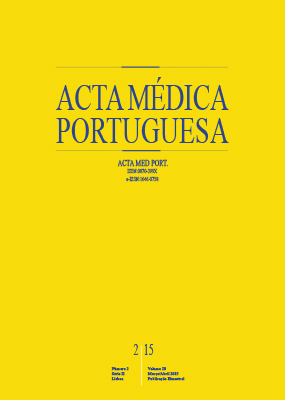Pharmacovigilance in Portugal: Activity of the Central Pharmacovigilance Unit
DOI:
https://doi.org/10.20344/amp.5717Keywords:
Adverse Drug Reaction Reporting Systems, Pharmacovigilance, Portugal.Abstract
Introduction: The aim of this study was to characterize the spontaneous reports of adverse events that were received by the Central Portugal Regional Pharmacovigilance Unit.Material and Methods: Spontaneous reports received between 01/2001 and 12/2013 were considered. The annual reporting ratios were estimated. The cases were characterized according to their seriousness, previous description, causality assessment, origin and professional group of the reporter, type of adverse event and pharmacotherapeutic groups of the suspected drugs most frequently reported.
Results: The Pharmacovigilance Unit received 2408 reports that contained 5749 adverse events. In 2013, the reporting rate was estimated at 171 reports per million inhabitants. Fifty-five percent of the reports were assessed as serious. Ninety percent of the cases were assessed as being at least possibly related with the suspected drug. The suspected drugs most frequently reported were antiinfectives for systemic use (n = 809, 33%). The most frequently reported adverse events were “Skin and subcutaneous tissue disorders” (n = 1139, 20%). There were 154 (6.4%) reports resulting in life-threatening situations and/or death, and 88 (3.6%) containing at least one adverse event assessed as serious, unknown and certain or probable.
Discussion: The present results are in line with those found in other studies, namely the seriousness and type of the adverse eventsand the pharmacotherapeutic groups of the most frequently reported suspected drugs.
Conclusion: In the last years, the Central Portugal Regional Pharmacovigilance Unit has registered a growth in the reporting rate in general, as well as an increase in the reporting of unknown and serious adverse drug reactions.
Downloads
Downloads
Published
How to Cite
Issue
Section
License
All the articles published in the AMP are open access and comply with the requirements of funding agencies or academic institutions. The AMP is governed by the terms of the Creative Commons ‘Attribution – Non-Commercial Use - (CC-BY-NC)’ license, regarding the use by third parties.
It is the author’s responsibility to obtain approval for the reproduction of figures, tables, etc. from other publications.
Upon acceptance of an article for publication, the authors will be asked to complete the ICMJE “Copyright Liability and Copyright Sharing Statement “(http://www.actamedicaportuguesa.com/info/AMP-NormasPublicacao.pdf) and the “Declaration of Potential Conflicts of Interest” (http:// www.icmje.org/conflicts-of-interest). An e-mail will be sent to the corresponding author to acknowledge receipt of the manuscript.
After publication, the authors are authorised to make their articles available in repositories of their institutions of origin, as long as they always mention where they were published and according to the Creative Commons license.









